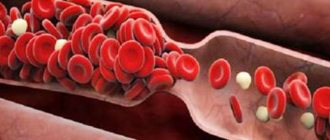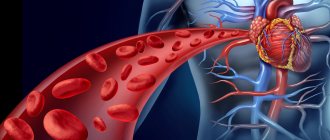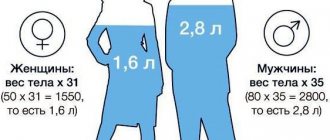This condition may indicate the presence of a serious pathology of the digestive tract. Each case of bleeding should alert not only the patient, but also the doctor. To make a diagnosis, it is necessary to undergo a complete examination of the body. Minor blood loss can later lead to serious complications and cost the patient his life.
There may be causes of bleeding from the anus that are not significant, but are characterized by serious diseases of the digestive system. Over time, the disease can become chronic and its symptoms become more frequent and more severe.
Bleeding can come from different parts of the digestive organs; the higher the organ is located, the darker the blood will be. When the source of bleeding is the lower gastrointestinal tract, then the blood discharge from the anus will be bright red.
When to call an ambulance?
There are several factors when you need to immediately call an ambulance if you are bleeding from the anus:
- When the bleeding is intense and does not stop for a long time;
- If the bleeding is accompanied by vomiting mixed with blood;
- During bleeding there is discharge from the nose, with the formation of bruises and hematomas;
- When, during bleeding, the patient experiences severe weakness and deterioration in general condition;
- Along with bleeding, the patient's temperature rises and severe abdominal pain appears.
Rectal bleeding
The nature and intensity of rectal bleeding depend on the underlying pathology. With anal fissures, patients complain of intense pain during bowel movements. Blood is separated in small quantities and is found in the form of small bright red smears on toilet paper. With hemorrhoidal rectal bleeding, similar symptoms may be observed, but there is no severe pain during defecation. Some patients experience prolapse of hemorrhoids. The blood is often bright scarlet, although dark clots are also possible. Rectal bleeding with hemorrhoids is more intense, and anemia may develop.
With diverticulitis, rectal bleeding develops relatively infrequently, but can be profuse, requiring emergency treatment measures. The type of blood depends on the location of the diverticulum. With damage to the sigmoid colon, the blood is bright red, with diverticula of the right parts of the colon - dark burgundy, sometimes almost black. Patients are concerned about abdominal pain, fever and hyperthermia resulting from inflammation of the mucous membrane of the diverticulum. Rectal bleeding due to diverticulitis may stop on its own and then recur after several months or even years.
Rectal bleeding with colon polyps can occur against the background of subjective well-being or abdominal pain and bowel movements. The intensity of such bleeding is usually low, but their frequent repetition can cause the development of anemia, especially with hereditary familial polyposis with the presence of a large number of villous polyps prone to bleeding.
Rectal bleeding with colorectal cancer is initially minor; blood can be detected in the stool in the form of clots or streaks. As the tumor disintegrates, the volume of blood released may increase. Along with anemia, abdominal pain and bowel disorders, common manifestations of cancer are observed: weakness, weight loss, lack of appetite, hyperthermia and intoxication syndrome. Rectal bleeding with angiodysplasia is not accompanied by any symptoms. There are no abdominal pains or bowel disturbances. Anemia may develop. The color of blood in polyps and cancer depends on the location of the node. The higher the tumor is located, the darker the blood that is released. With angiodysplasia, this pattern is less pronounced; the blood often has a bright red tint.
With rectal bleeding caused by proctitis and colitis of various etiologies, abdominal pain, diarrhea and pathological impurities in the stool are observed. Along with pus and mucus, streaks of blood may be detected in the fecal matter. In severe acute diseases and exacerbations of chronic forms of colitis and proctitis with severe clinical symptoms, rectal bleeding may increase, but significant blood loss is not typical. Radiation proctitis and colitis occur with similar symptoms; in most cases, rectal bleeding stops after completion of the course of radiation therapy.
Causes of bleeding
Causes of bleeding from the anus:
- Erosive gastritis and duodenal ulcer;
- For cirrhosis of the liver and thrombophlebitis of the veins of the spleen and esophagus; Signs of liver cirrhosis in men can be found here.
- Various oncological formations;
- Intestinal tuberculosis;
- Intestinal polyps;
- Ulcerative colitis of a nonspecific nature;
- Crohn's disease;
- Anal fissures;
- Varying degrees of hemorrhoids;
- Dysentery;
- Typhoid fever;
- Hemorrhagic fever;
- Helminthic infestations that can affect and injure the intestines;
- Venereal diseases of the genital organs;
- Salmonellosis;
- Enteroviruses.
Blood diseases:
- Leukemia;
- Mesenteric thrombosis.
Blood diseases
In diseases of the bone marrow and peripheral blood, clinical analysis shows intense anemia, a decrease in nominal cells and platelets. There are tumor cells in the bone marrow fluid.
For blood diseases, all symptoms are divided into several categories:
- All symptoms characteristic of anemia;
- Frequent fungal, colds and bacterial diseases, which also indicate a decrease in immunity;
- Acute platelet shortage. This indicates frequent nosebleeds, bruises and hematomas for no reason.
The cause of blood disease is the replacement of healthy blood cells with blast cells. These parasitic cells do not perform the necessary functions for the blood. To stop the process of replacing healthy cells with diseased ones, it is necessary to take cytostatics. If heavy bleeding is observed, the patient is transfused with red blood cells or other blood substitutes.
What to do if there is bleeding from the anus during bowel movements?
When you notice a slight admixture of blood in the stool, you need to contact a proctologist, who will prescribe you to undergo an examination and determine the cause of the bleeding. If the bleeding is intense and accompanied by poor health, then you need to call an ambulance.
There are several types of examinations that will help determine the nature of bleeding:
- The patient is prescribed to undergo sigmoidoscopy. This will help examine the lower intestines. As a result, hemorrhoids, anal fissure and neoplasms in the rectum and sigmoid colon can be identified;
- Colonoscopy . Deeper examination of the large intestine;
- Irrigoscopy. It is carried out by introducing a contrast agent and x-ray into the intestines;
- Fibrogastroduadenoscopy. An endoscope is used to examine the stomach and duodenum. During the study, a piece of tissue may be taken from the patient for a biopsy;
- Laparoscopy. This is a joint diagnostic and therapeutic procedure. This will allow you to completely examine the abdominal cavity and take fluid for a biopsy;
- Fecal occult blood test. It is very common that there is no bleeding, but there is an admixture of blood in the stool. If blood is detected in the analysis, then it is necessary to undergo the above examination. Treatment for bleeding from the anus depends only on the identified cause. And these may not always be serious pathologies, but it is simply necessary to see a doctor and get diagnosed.
Children are a special category of patients
Bleeding from the anus can also occur in children, even small ones. Such a symptom can cause well-founded panic in a young mother, because the appearance of blood is often a sign of a dangerous pathology. Thus, babies under one year old who are mixed-fed may suffer from diarrhea with bloody streaks due to an allergic reaction to cow's milk or other food components, or a deficiency of the lactase enzyme, which breaks down “milk sugar” - lactose.
A very serious cause of blood in the stool when the child is suddenly restless, has an increase in temperature and is vomiting can be volvulus or intussusception - an acute surgical pathology that requires immediate help for the baby.
After a year, when the child’s activity increases significantly, as does contact with other people, household objects and the street, the likelihood of intestinal infections of a viral and bacterial nature is high. In this case, along with bloody diarrhea, symptoms of general intoxication, fever, and often vomiting are expressed. The risk of rapid dehydration in the case of intestinal infections in children should be a reason to immediately seek help (call an ambulance).
A tendency to constipation and too dense feces can provoke an acute anal fissure in a child. In this case, special treatment is usually not required, observation is sufficient, but the diagnosis must be made by a doctor, to whom the mother and the baby must certainly go.
The age of the child does not matter much, be it a year, two or a month. Any suspicion of blood discharge from the anus, even in small quantities, is a cause for concern and consultation with a specialist.
In order to find out why blood is flowing from the anus, it is not enough just to evaluate the signs and choose from them those that are suitable for a particular patient. The listed most common causes of bleeding from the rectum can be combined in the same patient. So, with hemorrhoids, an anal fissure cannot be ruled out, and with a fissure, for example, cancer. To understand the true cause of this dangerous symptom, you need specialist consultation and additional examinations.
For examination, you should first of all contact a proctologist, who will examine, palpate the rectum and prescribe additional studies: sigmoidoscopy, ultrasound, irrigoscopy. If a tumor or colon polyp is suspected, a colonoscopy is indicated. If blood is released occasionally and in small quantities, then stool should be examined for occult blood using laboratory tests.
There is no single method of treatment for bleeding from the anus, because it is only a symptom of a variety of diseases, so only correct diagnosis will help you choose the most optimal and effective method of therapy.
Haemorrhoids
Hemorrhoids are accompanied by bleeding as a result of the expansion of hemorrhoids and their prolapse from the intestine. Bleeding usually occurs after bowel movements. When the blood does not completely leave the passage, it later appears in the stool in the form of clots. Also, mucous discharge from hemorrhoid cones leads to itching.
Manifestations
Hemorrhoids and bleeding occur in various pathologies:
- With constipation, childbirth and heavy lifting, pressure in the abdominal cavity is observed;
- Sedentary lifestyle and little movement;
- With stagnation of blood in the pelvis;
- Alcoholic drinks and spicy foods.
Treatment
Treatment for hemorrhoids can be conservative or surgical. Nowadays, there are many effective and modern methods of treating this disease.
Conservative treatment is as follows:
To begin with, the patient is prescribed the use of rectal suppositories. The drug contains hemostatic components to quickly stop bleeding, painkillers and anti-inflammatory drugs.- It is also necessary to take a special diet during treatment. The food should contain fiber; it is this that relieves the patient from constipation, which leads to the development of hemorrhoids. It is not recommended to consume spicy food and alcoholic drinks.
- You can use Zdorov cream wax. Price and instructions are described here.
The surgical treatment method is based on:
- The patient undergoes electrocoagulation of the hemorrhagic node , after which the tissue on it dies and falls off;
- Sclerotherapy is based on the introduction of a special agent into the node, which leads to the collapse of its walls. This technique can eliminate hemorrhoids of the first and third degree;
- Latex ligation. A ring is put on the base of the hemorrhagic node, as a result of which the node does not receive nutrition, and the blood supply to it is disrupted, and the tissue in it dies; During the surgical procedure, the surgeon excises nodes and lumps, and the wound is stitched.
Intestinal polyps
Polyps are considered benign intestinal growths. They are mushroom-like formations on a stalk. Sometimes the patient does not even realize that he has a polyp.
In exceptional cases, polyps can develop into tumors. The surface of the polyp itself may begin to bleed. When the polyp reaches a large size, in most cases it begins to bleed, which leads to bleeding from the anus.
We present to your attention an additional article about the causes of pain in the anus in men.
What needs to be done to stop bleeding during bowel movements: immediate first aid
If there is an insignificant amount of blood from the anus in men, for example, light smears or small spots in the stool, no specific actions need to be taken. It is urgently necessary to make an appointment with a proctologist, gastroenterologist or generalist and undergo a comprehensive diagnosis.
If moderate or intense bleeding is observed, accompanied by secondary negative signs indicating the development of acute diseases or exacerbation of chronic pathologies, then it is necessary to call an ambulance team, which will take the patient to the nearest specialized institution to provide qualified medical care.
Possible first aid actions for anal bleeding before the ambulance arrives:
- Use of cold. The product must be applied through several layers of material to prevent frostbite. Localization – pelvic area, abdomen;
- Use of absorbent materials. Apply superficially to the area of underwear and near the anus. Internal packing (except in cases of excessive blood loss, which directly threatens a drop in blood pressure or collapse of the vascular system) is not recommended until the initial examination by a specialized specialist;
- Administration of drugs. It is carried out in exceptional cases in case of a direct threat to life in situations where urgent delivery of the patient to a specialized medical institution is impossible. Medicines that increase blood clotting - vikasol, pituitrin, fibrinolysin, adrenaline.
Intestinal diverticulosis
With this pathology, pouches and protrusions form on the intestinal walls. This could cause weakness in the intestinal wall. Diverticulosis can also develop when pressure in the abdominal cavity increases. Basically, these sacs - diverticula - do not cause discomfort.
But when the sac ruptures and the inflammatory process begins, it is characterized by the following condition:
- The patient's temperature rises;
- The muscles in the lower abdomen tense;
- Bleeding appears;
- Sometimes, depending on the part, the blood may be scarlet or dark red;
- This condition is quite serious and requires immediate surgical intervention.
Infection
An intestinal infection develops when various pathogens enter it.
There are the following types of infection, which are divided according to the location of the process:
- Colitis;
- Pancreatitis;
- Duodenitis;
- Gastritis.
Causes:
- Water containing microbes;
- Poor quality products;
- Poor personal hygiene;
- Communication with an infected person;
- Expired food products;
- Working on the ground.
Almost all intestinal infections are accompanied by the development of the following symptoms:
- Abdominal pain;
- Increased gas formation;
- The temperature rises;
- Nausea and vomiting appear;
- Diarrhea.
You cannot treat the infection on your own . Disordered stools, especially those mixed with blood, lead to dehydration.
Digestive diseases
When the digestive system malfunctions, diseases begin to appear.
There are several most common diseases of the digestive tract:
- Gastritis;
- Dysbacteriosis;
- Stomach and duodenal ulcers;
- Colitis;
- Gastroduodenitis;
- Reflux – esophagitis;
- Cholecystitis;
- Pancreatitis;
- Constipation;
- Diarrhea.
Causes:
Poor quality food;- alcohol abuse;
- stress and depression;
- smoking;
- taking medications for a long period;
- heredity;
- Decreased immunity;
Symptoms:
- Pain of varying localization and intensity;
- Soreness can radiate to various organs and systems;
- The patient's appetite decreases;
- Heartburn and belching appear;
- Nausea and vomiting;
- Increased flatulence;
- Constipation or diarrhea.
Treatment of diseases of the digestive tract is based on taking medications to reduce inflammation and pain. Also, together with the medicine, the patient is prescribed a special diet.
Blood from the anus in men
Causes of bleeding from the anus in men:
- Haemorrhoids;
- Anal fissure;
- Intestinal polyp;
- Intestinal diverticulosis;
- Rectal cancer;
- Crohn's disease;
- Intestinal infection.
It is quite difficult to independently determine the cause of blood from the anus. To establish an accurate diagnosis and cause of the pathology, it is necessary to undergo an examination. Many men believe that blood is just the cause of hemorrhoids and put off visiting a proctologist. But this is a serious symptom that can eventually develop into cancer.
Gastric and duodenal ulcers and erosive gastritis
Causes peptic ulcers of the stomach and duodenum, as well as erosive gastritis for the following reasons:
- Helicobacter pilari bacillus;
- increased acidity;
- long-term use of non-steroidal, anti-inflammatory drugs;
- unbalanced diet;
- smoking;
- alcohol abuse.
An accurate diagnosis is established after fibrogastroduodenoscopy.
Symptoms:
- Pain in the epigastric region;
- Typically, pain is characterized immediately after eating or on an empty stomach;
- Flatulence;
- Bloating;
- Belching and heartburn.
Intestinal and other infections
An intestinal infection is characterized by the following symptoms:
- Loose stools mixed with mucus and blood;
- Nausea and vomiting;
- Temperature increase.
The cause of such symptoms may be salmonellosis, dysentery, or infestations.
Tumors of the digestive organs
The most common tumors of the digestive organs are:
- Stomach cancer;
- Bowel cancer.
Risk factors:
- Heredity;
- Smoking;
- Helicobacter pilari bacillus;
- Unbalanced diet;
- Consuming a small amount of plant fiber;
- Intake of refined foods;
- Polyps.
Varicose veins of the esophagus
Varicose veins of the esophagus are characterized by a violation of the outflow of blood from the veins of the esophagus. According to statistics, the age of this pathology occurs at 50 years. This occurs more often in men than in women.
Causes:
- Hypertension in the portal vein basin;
- Cirrhosis of the liver. Its symptoms in men are highlighted here.
- Hepatitis; We present to your attention an article about the first symptoms of hepatitis C here.
- Disease of the heart and blood vessels;
- Tuberculosis.
Symptoms:
- Belching;
- Heaviness in the chest;
- Heartburn;
- Nausea and vomiting.
Inflammatory bowel diseases
Nowadays, pathologies such as ulcerative colitis and Crohn's disease are quite common.
These are different diseases, but they have the same symptoms:
Pain and colic on the right and left sides of the abdomen;- Presence of feces in the blood;
- Bleeding from the anus;
- Dehydration;
- Loss of body weight;
- Damage to the eyes, liver, heart, blood vessels;
- Skin rashes;
- Thromboembolic complications.
Crohn's disease and ulcerative colitis
Crohn's disease and ulcerative colitis are dangerous diseases that affect the intestines and are accompanied by a pronounced inflammatory process, the formation of erosions and ulcers on the surface of the mucous membrane, which leads to vascular damage and, accordingly, bleeding from the anus. The diseases are usually detected in middle-aged people, more often women.
Nonspecific ulcerative colitis and Crohn's disease are characterized by pain, diarrhea, and possibly an increase in body temperature. Features of bleeding include bloody diarrhea and the release of blood clots in feces. When the pathological process is localized in the upper parts of the colon, the appearance of stool is tarry, almost black.
Treatment of nonspecific ulcerative colitis is a complex task that usually faces a gastroenterologist. Glucocorticoids, sulfasalazine, 5-aminosalicylic acid preparations, cyclosporine A are considered effective. For Crohn's disease, immunosuppressants, hormonal drugs, and sometimes antibiotics are prescribed, and the basis of therapy is sulfasalazine, which has a pronounced anti-inflammatory effect.
Bottom line
If there is minor bleeding from the anus, you must contact your local physician or proctologist and undergo an examination. Frequent bleeding can lead to anemia and the formation of a malignant tumor.
Mostly in men, bleeding is associated with hemorrhoids and anal fissure . If treatment is not started in time, the disease will become chronic and difficult to respond to treatment. When the bleeding is profuse and does not stop within 15 minutes, you need to call an ambulance and take the patient to the hospital.
Treatment with folk remedies
Since bleeding from the anus can be a sign of a dangerous disease, treatment with homemade herbal medicine recipes should be carried out only after examining the body and consulting a doctor. We bring to your attention the most effective healing recipes:
- Therapeutic bath . Take a special sitz bath with a decoction of St. John's wort, chamomile or calendula twice a day. It is recommended to carry out the procedure after a hygienic shower. Take 3 tbsp per liter of water. l. selected raw materials and boil for 5 minutes, after cooling, filter and pour into a bath. Such decoctions can be used for baths if the body itches in different places without serious reasons.
- Periwinkle decoction . Boil 1 tbsp. l. Lesser periwinkle leaves in a glass of water for 20 minutes, after cooling, strain and use for enemas and compresses.
- Microenema of chamomile and sea buckthorn oil . Boil 1 tbsp. l. chamomile in a glass of water for 5 minutes. After cooling, strain. Mix 100 ml of decoction with 30 ml of sea buckthorn oil and carefully insert into the anus shortly before bed. Try to hold it in for as long as possible.
- Microenema made from honey and chamomile . Prepare a chamomile decoction as indicated in the previous recipe. Mix 100 ml of liquid with 1 tbsp. l. honey carry out the procedure in the same way as described in the previous recipe.
- Ointment made from propolis and olive oil . Mix 2 tbsp. l. these components and simmer in a water bath until smooth for 40 minutes. Apply to damaged anus twice daily. Propolis is recommended for use in inhalation for coughs.
- Healing infusion . Grind and mix thoroughly 1 tbsp. l. sage, chamomile and calendula. Pour boiling water over the mixture and leave for half an hour, then strain. Use for compresses, lotions, enemas.
- Veronica infusion . Infuse 2 tbsp in a thermos. l. medicinal veronica in 400 ml of boiled water for 2 hours, then strain. Divide the resulting medicine into 4 times and drink it per day.
- Potato . Carefully cut out a rectal suppository from a potato tuber without sharp corners and insert it into the anus, smeared with rosehip or sea buckthorn oil. Potato juice helps with headaches and nausea.
- Therapeutic tampon . Mix 1 tbsp. l. freshly squeezed aloe juice with a raw chicken egg and 1 tbsp. l. fish oil. A tampon is made, moistened with this mixture and inserted inside.
- Dandelion . Grind the dried root of the plant into powder and eat 1 tsp on an empty stomach. in the morning and before bed, with water.











